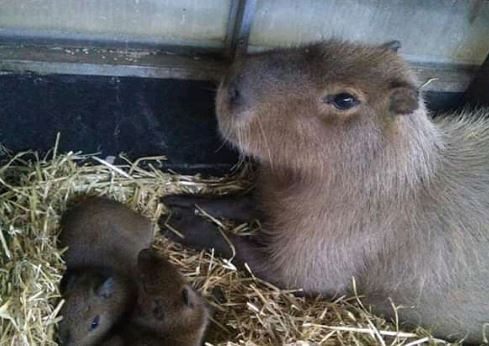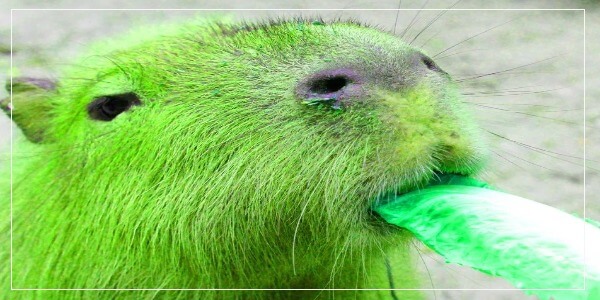In my previous article, I wrote some mind-blowing facts about Capybaras you probably don’t know, and here I will be unveiling the top relationship between capybaras and water, which brought about the question many people have been asking if capybaras are naturally obsessed with water or why do they like to reside near rivers.
Capybaras are semi-aquatic in nature, the largest rodents, and the most friendly animals in the world. They are mammals found mostly across South American countries, although not yet recorded in Chile. They don’t live far from the tropical rainforest, marshes, rivers, lakes, ponds, and swamps.
Capybaras are good swimmers. They can stay underwater for about 5 minutes. If you are looking for calm animals, capybaras are your favorite tame and quiet creatures.
They are great lovers of the aquatic environment; most of their lifestyles and daily and daily routines revolve around water.
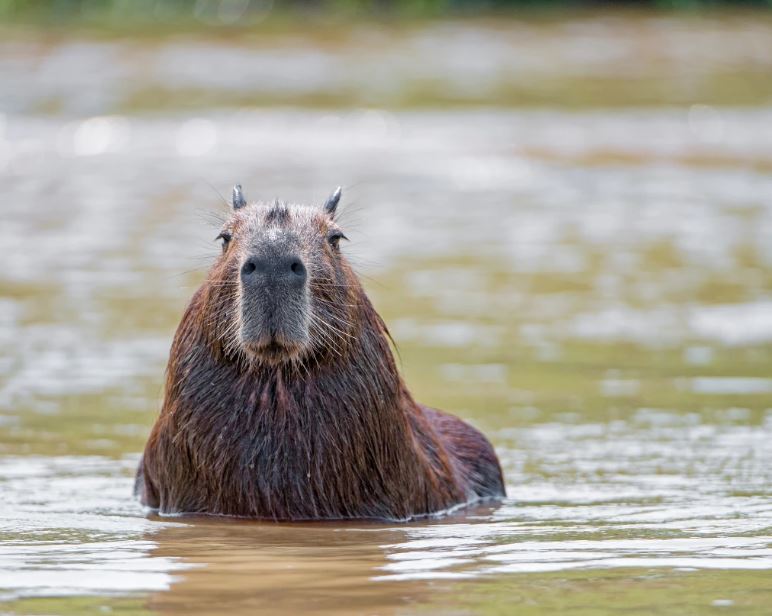
The giant rodents secure themselves inside water whenever a predator is sighted, and also they jump into the water to regulate their body temperatures and moisturize their dried skin. This is part of the reason capybaras are popular around rivers, streams, lakes, swamps, and ponds.
Capybaras are not just obsessed with water, but water is considered part of their lives as they use the rivers for their protection against attackers. They also find their favorite food (made up of delicious grass and plants) around water. They bathe, play, and have fun in the water.
Your pet capybaras could be depressed if you don’t provide a pool of water for them because water is a key element or part of their life. If you consider adopting a pet capybara, then be sure to fix a pool of water around where they will reside.
Let me quickly discuss the following points below to better understand what water means to a capybara pet.
- Do Capybaras Enjoy Swimming?
- Are Capybaras Good Swimmers?
- Why Do I Have To Provide a Water Pool For My Pet Capybara?
- Are Capybaras Defenseless Without Water?
- Can Capybaras Stay An Hour Under Water?
- Capybaras Body Temperature & Water
- Is Water Safe For Capybaras?
- Keeping Capybaras Pool Of Water Clean & Healthy.
Do Capybaras Enjoy Swimming?
These giant rodents are really obsessed with water, so as good jumpers, they would dive into it to cool off & have fun. They are happy, soft, and calm pets whose daily activities can’t be complete without water.
Yes, swimming is their hubby/sporting activity, but these giant rodents not only swim, but they also find delicious & favorite food – plants around the water.
There is a deep connection between capybaras and water as they spend a lot of time in the water. This is not just an obsession but a lifestyle that promotes their overall health and well-being. Having a capybara pet requires you to make water available within the site you want to raise them.
Are Capybaras Good Swimmers?
It should be noted that Capybaras are semi-aquatic mammals, which means naturally, they are born swimmers, and most of their time and activities take place in the water.
Capybaras like to stay very close to the water; this is one of their prominent characteristics and lifestyle. You mustn’t stop even if you want to take one home as your pet.

They are very good swimmers. No wonder they have webbed paws and feet, perfectly structured for the purpose of swimming. Not just capybaras alone, but other mammals with aquatic traits have it, the reason they could swim excellently.
Capybaras have strong legs that help them swing, slide or propel themselves better in the water during swimming. They also possess wiry hairs, oily skin, and thick skin, enabling them to beat resistance and move smoothly when swimming.
So, you can confidently say that copies are excellent swimmers.
Can Baby Capybaras Swim?
Baby capybaras can’t swim; they would spend their early months after birth living near the water because they are not excellent swimmers. Gradually they are introduced and nursed into swimming by older female capybaras.
Capybara puppies hide under bushes around the water to stay safe until they are better at swimming.
Why Do I Have To Provide a Water Pool For My Pet Capybara?

In my previous post about housing a capybara, I told you that your first consideration is providing a pool of water where your pet can live his natural lifestyle as a semi-aquatic creature.
I also told you in that article not to buy or adopt one capybara only because the giant rodents need the company of their kind to live better. So you must adopt at least two and provide a body of water that will be enough for the pair.
Water should be available in the territory where they are kept. This will help them feed, graze better, swim, and reproduce. Your capybaras need an ideal ecosystem as natural as the rainforests, savannas, and areas with water bodies.
Water banks, bushes, and waterfronts attract the family of capybaras. This is why they will migrate from places that lack their natural ecosystem to where there is abundant water.
The availability of water makes a capybara live its natural life and also secures itself from external attackers or predators.
Are Capybaras Defenseless Without Water?
Truth be told, capybaras will be extremely vulnerable and become a delicious meal for their predators if they stay in the bush where there is no water bank around.
Capybaras are agile, skillful, and run up to one hundred to two hundred meters in distance, yet they can’t be compared to how fast a dog can run. These animals easily get tired, affected by the sun’s rays, which burn their skin and raise their temperature.
Therefore, they always find a way to jump into the water to cool off and hide from predators if they sense any attack.
Lack of water in areas where capybaras dwell leaves them defenseless, and as such, they would migrate to find a safer territory with an abundance of water. This is why capybaras live near rivers, lakes, streams, and samples.
Your pet capybara could get sick and even die if it eventually runs into hyperthermia (overheated body, usually in response to prolonged hotness). This is why the animal needs water close by to help him regulate and balance its temperature.
Your capybara also needed a shaded place, trees, and bushes to keep cool all the time.
Can Capybaras Stay An Hour Under Water?
The maximum time a capybara could stay underwater while hiding from predators is between 5-10 minutes.

Capybaras defend themselves as other animals do, but one known way is to dive into water if they sense any enemy around them.
Jacare and Anacondas are common enemies of capybaras. As intelligent mammals, they will always swim only in rivers or waters familiar to feel safe and secure.
READ ALSO: How Do Capybaras Survive and Stay Alive?
Capybaras Body Temperature & Water
Capybaras suffer sunburn, which affects their skin and overall body temperature. Your pet capy needs water to stabilize or cool down his skin. Apart from that, water plays another role in washing and cleaning their dirt and debris.
Anatomically, the capybara skin has a sweat gland with wavy, containing numerous folds and cavities. Three groups of Hair follicles in the dermis contain numerous hair follicles, each with sweat glands.
Capybaras like to crawl in the mud to moisturize their skin when sunburn hits hard. This habit helps them regulate their temperature. Doing this makes a capybara look very dirty.
The good thing is water must always play the role of cleaning, and the animal will dive in and have a clean bath.
Is Water Safe For Capybaras?
Capybaras consider the body of water as a major defense mechanism to hide away from predators, especially when they have lived around the water for some time and have become familiar with it.
But sometimes, capybaras get eaten by their enemies right in the pool of water. I have seen videos where capybaras are attacked by anacondas or caimans inside the water.
A typical example is a scenario where an anaconda chased a capybara and got eaten by a caiman. So sometimes, it is cool to say that nowhere is 100% safe for harmless giant rodents, despite water’s huge role in their lives.
Keeping Capybaras Pool Of Water Clean & Healthy
Capybara activities such as mating, security, feeding, and hiding happen around water and as cute rodents who like to live in a clean environment. You must ensure the pool and territory be kept very clean.
If you consider getting a pair of capybaras, you ensure you provide a clean pool of water for them to swim, have fun, and moderate their body temperature.
Remember, capybaras also drink and defecate in the pool, so as a breeder, you must always checkmate their activities and notice when the pool needs to be cleaned up for the well-being of your capy pets.
Do you have any questions after reading this post? kindly ask using the comment section below and we will fastly attend to it. Thanks for reading and don’t forget to share this with someone.

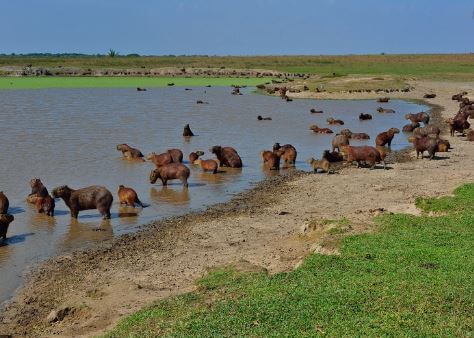
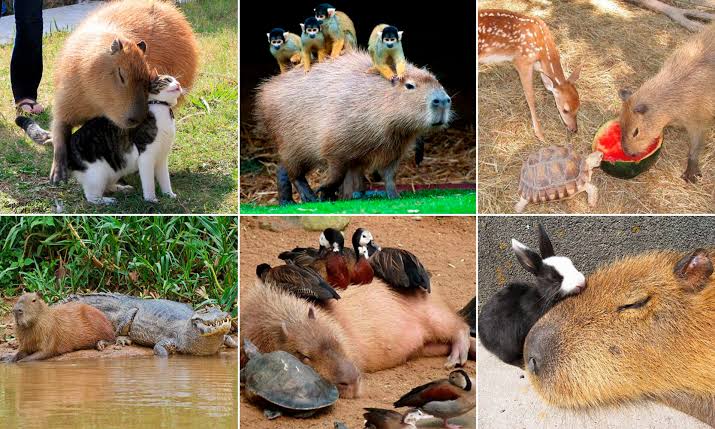

![Why Do Capybaras Not Have Tails? - [Answered] Why Do Capybaras Not Have Tails](https://capybaratips.com/wp-content/uploads/2023/03/Capy-Tail-250x200.webp)
![How Long Do Capybaras Live? - [Answered] How Long Do Capybaras Live](https://capybaratips.com/wp-content/uploads/2023/03/Capybara-Pix-250x200.webp)


